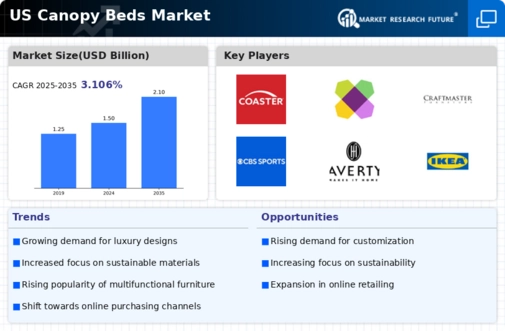Growth of E-commerce Platforms
The canopy beds market is experiencing growth driven by the expansion of e-commerce platforms, which provide consumers with convenient access to a wide range of products. Online shopping has transformed the way consumers purchase furniture, allowing them to compare prices, read reviews, and explore various styles from the comfort of their homes. In 2025, e-commerce sales in the furniture sector are projected to reach approximately $50 billion in the US, indicating a substantial shift in consumer purchasing behavior. The canopy beds market is poised to capitalize on this trend, as online retailers increasingly offer customizable options and exclusive designs that cater to diverse consumer preferences.
Shift Towards Luxury and Comfort
The canopy beds market is witnessing a notable shift towards luxury and comfort, as consumers increasingly prioritize their sleeping environments. This trend is fueled by a growing awareness of the importance of quality sleep and its impact on overall well-being. Canopy beds, often associated with elegance and comfort, are becoming a preferred choice for those looking to enhance their bedroom experience. The luxury furniture segment in the US is expected to grow at a CAGR of around 5% over the next few years, indicating a robust market for high-end products. The canopy beds market stands to gain from this shift, as consumers are more inclined to invest in premium options that offer both style and comfort.
Influence of Interior Design Trends
The canopy beds market is significantly influenced by evolving interior design trends that shape consumer preferences. As design styles shift towards eclectic and bohemian aesthetics, canopy beds are being embraced for their ability to add character and charm to bedrooms. Designers are increasingly incorporating canopy beds into their projects, recognizing their versatility and visual impact. The interior design market in the US is projected to grow at a CAGR of around 4% over the next few years, suggesting a favorable environment for the canopy beds market. This influence of design trends encourages consumers to invest in statement pieces like canopy beds, further driving market growth.
Rising Popularity of Minimalist Designs
The canopy beds market is adapting to the rising popularity of minimalist designs, which emphasize simplicity and functionality. As consumers gravitate towards decluttered living spaces, the demand for sleek and understated furniture increases. Canopy beds, traditionally seen as ornate, are now being reimagined in minimalist styles that appeal to modern sensibilities. This shift is reflected in the broader furniture market, where minimalist designs are projected to account for a significant share of sales in the coming years. The canopy beds market is likely to benefit from this trend, as manufacturers innovate to create designs that align with minimalist aesthetics while maintaining the essential features of canopy beds.
Increasing Consumer Interest in Home Decor
The canopy beds market is experiencing a surge in consumer interest driven by the growing emphasis on home decor. As individuals increasingly seek to create personalized and aesthetically pleasing living spaces, the demand for unique and stylish furniture, including canopy beds, rises. This trend is particularly evident among millennials and Gen Z consumers, who prioritize design and functionality. According to recent data, the home furnishings market in the US is projected to reach approximately $200 billion by 2026, with a notable portion attributed to bedroom furniture. The canopy beds market benefits from this trend as consumers are willing to invest in high-quality, visually appealing products that enhance their living environments.























Leave a Comment